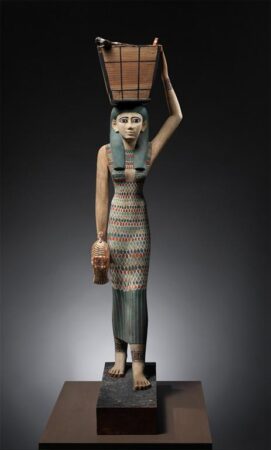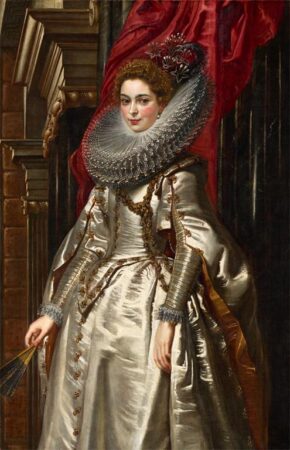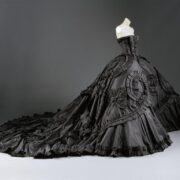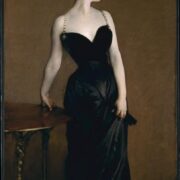Walking the red carpet through history: Fashion in Artstor
It may come as a surprise that JSTOR is flush with fashion. For a dose of glamour, how about a stroll down the red carpet, exploring designs through the ages?
Let’s begin with the ancients: In early dynastic Egypt, the beadnet sheath dress is often depicted in paintings and statuary. A faience (sintered-quartz ceramic) dress from the Museum of Fine Arts, Boston, reconstructed from thousands of beads found in a burial site, is our oldest surviving example from approximately 2551–2528 BC (this particular garment was used to dress a mummy). In life, these decorative nets were probably worn over plain linen sheaths, giving an effect that approximates the elegant lines of a deftly carved offering figure from the tomb of Meketre (c. 1981-1975 BCE). A similar silhouette is achieved five millenia later in an evening gown by the pioneering American designer Norman Norell through the layering of a peach satin under slip and black rhinestone beaded netting (c. 1963).
The classical cool of the Greek and Roman goddess dress has long been prized by designers who have recast the draperies of figures like the Caryatid from Hadrian’s Villa, (c. 130 CE). Madame Grès repurposed the aesthetic to perfection, as exemplified by her white silk column dress (1937), a design that is remarkably free of structure for its time.
- Peter Paul Rubens. Marchesa Brigida Spinola Doria. 1606. Image and data courtesy the The National Gallery of Art, (Washington D.C.)
- Charles James. Ball gown. 1951. Image and original data from the Brooklyn Museum. Image © The Metropolitan Museum of Art.
Leaving behind the elegance of antiquity, behold the exuberance of the Marchesa Brigida Spinola Doria (1606), a Genoese aristocrat depicted by Peter Paul Rubens — resplendent in voluminous shimmering cream satin, ostensibly her wedding attire as this was probably painted as a bridal portrait. Charles James provides the less demure mid-century version of the Marchesa’s dress in his 1951 ivory satin ball gown. A veritable construction with four hipline poufs, it was worn by a Chicago debutante for her coming out.
- Elisabeth Louise Vigée-LeBrun. Archduchess Marie Antoinette, Queen of France. 1778. Image and original data provided by Erich Lessing Culture and Fine Arts Archives/ART RESOURCE, N.Y.
- Court dress. British. c. 1750. Image © The Metropolitan Museum of Art.
No slouch as a consumer of extravagant fashion, Marie Antoinette wears another extreme look in her portrait of 1778 painted by Elisabeth Louise Vigée-LeBrun. By this time the young monarch was fully in the thrall of designer Rose Bertin, dubbed the “Minister of Fashion” by the scornful French. A robe à la française, c. 1750, attests to the volume of the skirt, supported by outsized panniers typically constructed of willow or whalebone. By its very design such a garment precluded work or activity. Its wearer would have to turn sideways to enter a room.
- House of Dior. Maria-Luisa (dite Coré). 1998. Image © The Metropolitan Museum of Art.
- John Singer Sargent. Madame X. 1883-84. Image and data courtesy the Metropolitan Museum of Art.
From the house of Dior, John Galliano’s sweeping Maria-Luisa gown (1998) reprises the silhouette à la française, recasting it in black. Slimming back down to the more refined lines of antiquity, the black velvet, dramatically décolleté dress of Madame Gautreau in her 1883-1884 portrait actually crushed her reputation in society. Further, the artist John Singer Sargent was obliged to sell the painting to the Metropolitan Museum years later under the anonymous name of Madame X.
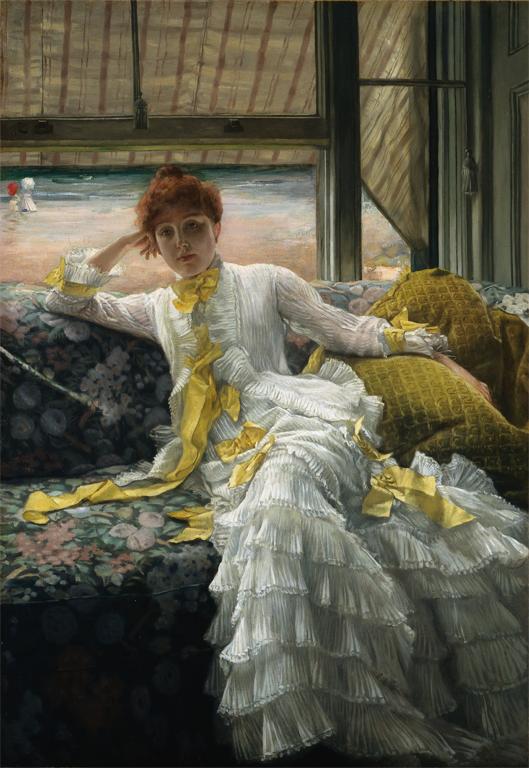
Jacques-Joseph Tissot. Seaside. c. 1878. Image and data courtesy the Cleveland Museum of Art.
A confection of striped white muslin frills and yellow taffeta bows enshrouds the figure of Kathleen Newton in Seaside (1878) by the painter Jacques-Joseph Tissot, her companion. Tissot’s love of fashion and his genius for painting textiles doubtless originated in his upbringing: his father was a linen draper and his mother a milliner.
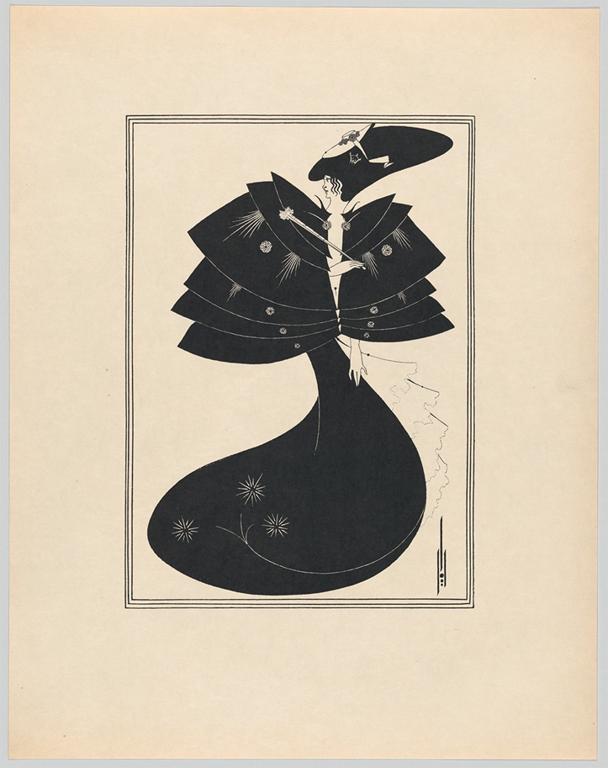
Aubrey Vincent Beardsley. Aubrey Beardsley’s Illustrations to Salome by Oscar Wilde. 1906-7. Image and data courtesy the Metropolitan Museum of Art.
The spiky black cape in Aubrey Beardsley’s illustration for Salomé by Oscar Wilde (1906-1907) provides a foil to Newton’s airy, light gown. Hovering like layers of armor above a serpentine skirt, it enshrines and protects the heroine. Beardsley brought Japonisme and black-and-whites to the Victorians.
We turn to Christian Dior, “monarch of haute couture,” for the last word: “In an epoch as somber as ours, luxury must be defended inch by inch.”
–Nancy Minty, Collections Editor
For relevant collections in JSTOR, please visit:
Allegheny College Talon Zipper Collection
Gazette du Bon Ton (Minneapolis College of Art and Design)
Magnum Photos (includes portraits of designers)
The Museum at FIT (Fashion Institute of Technology)
RISD Library Picture Collection: Edwardian Fashion Plates
For ritual and ceremonial attire across global cultures, visit:
Peabody Museum of Archaeology and Ethnology (Harvard University)
Museum of Anthropology at the University of British Columbia

